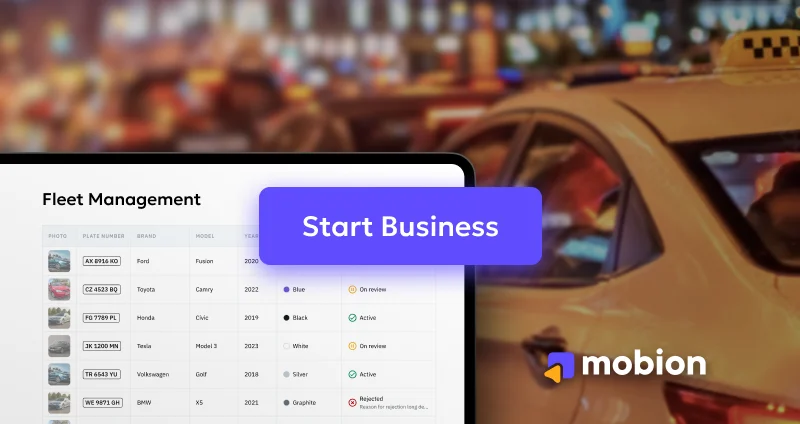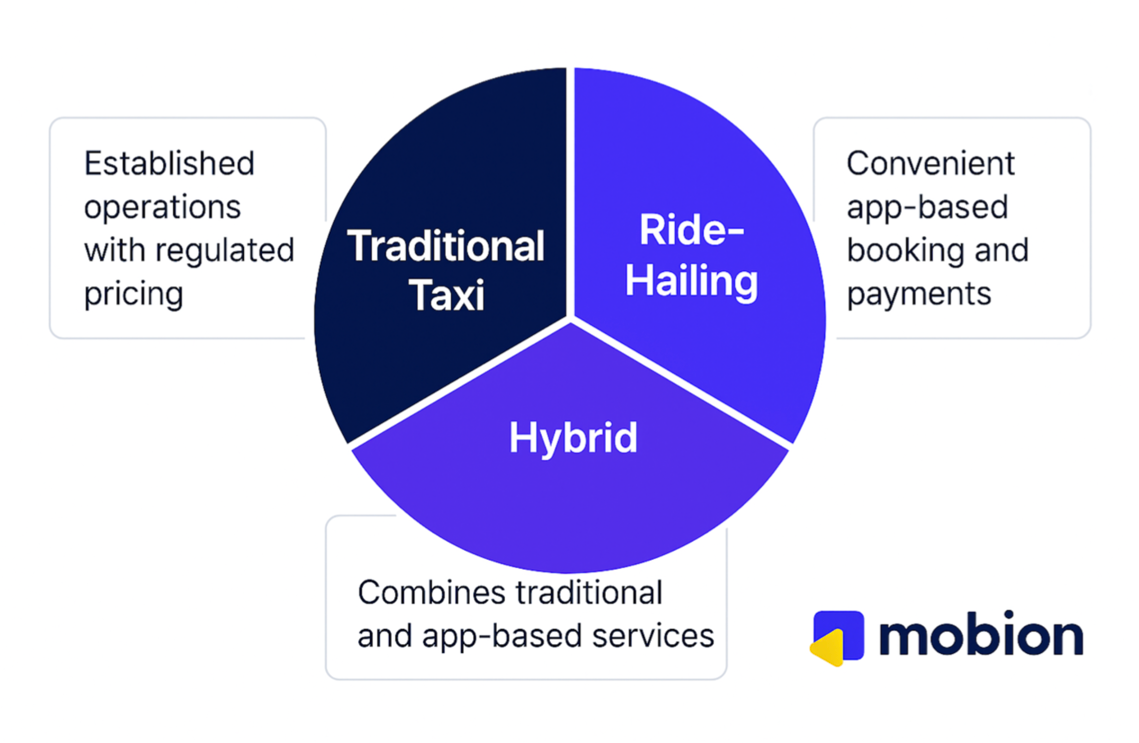How to Start a Taxi Business: Complete Guide for 2025


Starting a taxi business isn’t just about buying a few cars and putting logos on the doors. In 2025, customers expect more. They want a ride that feels quick to order, safe to take, and fair on price. That’s a lot to balance if you’re just getting started. At the same time, it’s also why the market is still open for new companies. When riders feel let down by slow response times or confusing apps, they’ll switch the moment they see a better option.
The first step is usually a business plan, but don’t overthink it. You don’t need a 50-page document, you just need to know who you’re serving and how you’ll run daily operations. The real difference maker is technology. Without the right tools, you’ll spend your nights on the phone trying to match drivers with passengers. With modern software, those headaches disappear.
That’s why many new operators turn to Mobion Tech. Instead of patching things together, you get a ready setup that handles dispatch, tracking, and driver communication. It’s not about replacing people, it’s about making their work easier. And when drivers are happy, customers usually notice.
How to Start Taxi Business in Today’s Market
If you are thinking about starting a taxi service today, the rules of the game are not what they used to be. A small company in 2010 could survive with a few cars and a phone number stuck on billboards. That is not enough anymore. Riders now expect to see where their driver is, how long the wait will be, and what the trip will cost before they even get inside the car.
The truth is the market is still growing. One industry report valued the global taxi and ride-hailing sector at around 260 billion dollars in 2023. Forecasts suggest it could add another 90 billion within just four years. That is a huge number, but it also explains why the competition feels tough
When setting up a taxi business, you cannot just think about cars. Riders compare apps in seconds, and drivers look for platforms that make their work simple. If they do not find it with you, they switch. For example, in New York City, drivers often mention that navigation support and clear payouts matter as much as getting enough rides.
Add to this the paperwork: local permits, insurance, and safety checks. They are not fun to deal with, yet skipping them can stop your launch completely. Still, companies that manage to pair solid compliance with better service usually find their audience. Sometimes it is as simple as faster pick-ups or a friendlier driver that keeps people coming back.
Choosing the Right Model for Your Taxi Business
At Mobion we often meet entrepreneurs who face the same question: should they invest in their own fleet or build a platform for independent drivers. The decision is critical, because it defines costs, growth speed, and even the reputation of the new taxi service.
Owning a fleet offers full control. Cars are branded, drivers are trained, and service quality stays consistent. The challenge is the financial load. Our data shows that in Europe, the annual cost of keeping one taxi on the road reaches about 11,500 to 12,000 dollars. For a fleet of 15 cars, that already means more than 170,000 before profit. On the positive side, operators who manage their own cars often retain close to 70 percent of each fare after covering expenses.

Aggregator models reduce that pressure. Startup budgets can be cut by half, because drivers use their own cars. But loyalty becomes an issue. Statista reports that in 2023, 4 out of 10 drivers worked for two or more platforms at the same time, which makes it harder to build a stable team.
Many new companies now combine both approaches. A small owned fleet guarantees reliability, while partner drivers help cover demand during peak hours. From our perspective, this hybrid model gives balance between control and flexibility, which is often the safest way to grow.
How to Start a Taxi Service Legally
After choosing the right business model, the next step is making sure your service is legal. It may sound like paperwork, but without it even the best idea cannot survive. Authorities pay close attention to safety, insurance, and licensing, and missing one detail can stop operations before the first ride.
The core requirement is a taxi business license. This looks different depending on the city. In New York, a traditional medallion license can cost more than 100,000 dollars. In Berlin, operators pay much less, but cars still need to pass safety checks every 12 months. In smaller cities across Eastern Europe, licenses are easier to obtain, yet still require background checks for drivers and commercial insurance.
Insurance itself is a significant cost. Full coverage for one car usually runs between 1,250 and 1,800 dollars a year. In London, some fleets report even higher numbers when drivers are under 25. Cutting corners here is risky. One accident without proper insurance can end the entire company.
At Mobion we see that companies who set up strong compliance early grow faster later. Customers also notice. A rider is more likely to trust a service when they know drivers are licensed and cars are insured.
Legal preparation may not feel exciting, but it builds the foundation for marketing, expansion, and eventually scaling to a larger fleet. Without it, growth is impossible.
Crafting a Business Taxi Plan
A legal foundation is important, but it is only the beginning. What really drives success is a clear plan. At Mobion we often notice that operators who skip planning face unexpected bills in the first year. A business plan protects against that and gives a roadmap for growth.
The taxi service business plan startup costs usually begin with vehicles. Buying ten cars can require around 149,000 dollars. Leasing reduces upfront spending, yet monthly payments of 420 to 480 per car often catch up within five years. Technology is another major item. A dispatch platform with mobile apps may cost between 9,000 and 14,000 dollars annually. Add insurance at about 1,300 per car, licenses, and marketing campaigns, and the first-year budget for a small fleet can approach 197,500 dollars.
Good planning is not only about expenses. Smart taxi business ideas can create extra revenue and reduce risk. In many cities, companies secure corporate contracts that bring dozens of rides each week. Partnerships with hotels and restaurants are another way to keep cars busy. Eco-friendly options also matter. In Oslo, for instance, fleets with hybrid cars received tax breaks of up to 12 percent while attracting new customers.
The most effective plans are flexible. Markets shift, fuel prices rise, and new players enter. Companies that review their plan every few months adapt faster and waste less money. In practice, the plan is not just paperwork. It is the structure that separates long-term businesses from short-term experiments.
Budgeting, Fleet Selection, and Startup Costs
When people ask us how much does it cost to start a taxi business, the truth is simple: more than most expect.
Cars:
- Buying ten mid-range vehicles = roughly 149,000 dollars.
- Leasing seems cheaper, but at 420 - 450 per month, per car, you often pay nearly the same in five years.
- Fuel and maintenance? Operators tell us almost nine thousand a year, per car, just to stay on the road.
Tech:
Dispatch software, driver apps, rider apps. In practice, you spend between
9,200 and 13,800 a year. Custom features push that higher.
Insurance & Licenses:
- Insurance: from about 1,200 to 1,800 per car, depending on the city.
- Licenses: a few hundred in smaller towns, several thousand in major hubs.
- Add it up and the first year for a 10-car fleet usually lands between 190k and 220k.

Some operators cut costs by starting with hybrids. Lower fuel bills, and sometimes up to 12% tax breaks. Others mix leased and owned cars to balance cash flow.
At Mobion we recommend writing the budget down before a single car hits the road. It is the difference between a startup that survives and one that burns out.
Leveraging Software for Taxi Business
In reality, no taxi company today can grow without digital tools. Riders expect a car in minutes, not after a phone call. Drivers want apps that make navigation simple and payments clear. Owners need facts, not guesses, about how cars are being used. Software for taxi business ties these needs together.
It is not just dispatching anymore. Good platforms bring everything under one roof: booking for passengers, live updates for drivers, and reporting for managers. In 2023 nearly 1.5 billion people used ride-hailing apps worldwide. The figure is still climbing every month, and it shows how much technology has become the standard way to move.
This part often surprises new operators: the money saved can be bigger than the money spent. Fleets that adopted digital systems cut wasted trips and lifted driver productivity by about 15 to 20 percent. Shorter wait times also mean riders come back more often instead of switching to a competitor.
At Mobion we treat software as the backbone of a taxi service. Our taxi service software is designed to keep operations smooth, drivers informed, and passengers happy. For startups it is often the difference between breaking even and running at a loss. For larger fleets it is what keeps scaling possible.
Common Pitfalls and How to Avoid Them
Running a taxi service brings a set of challenges that new operators often underestimate.
Operating costs. Fuel, repairs and insurance take a heavy share of income. In large U.S. cities, fleets lose around 35 to 40 percent of revenue here. On average, one car costs about 12k a year to keep in service.
Customer experience. PwC found that 59 percent of people stop using a company after only a few negative experiences. For taxi services this can mean two missed rides. Each rider lost is direct revenue gone.
Driver turnover. Replacing a driver costs about 4k when recruiting, training and checks are included. High turnover disrupts service and lowers passenger trust.
Technology delay. Manual dispatch may handle ten cars but it fails once the fleet grows. Companies that adopt dispatch software early often gain 15 to 20 percent higher productivity and complete more trips.
Knowing how to grow taxi business means recognizing these risks early and building processes that reduce them.
Conclusion and Next Steps
Running a taxi company today is not only about dispatching cars. Growth depends on how well operators balance service quality, technology, and costs.
Fleets that work with Mobion often notice:
- More trips per driver after introducing automated dispatch
- Lower turnover once drivers feel supported and motivated
- Higher repeat bookings because passengers trust consistent service
- These gains lead directly to stronger revenue without raising marketing budgets.
If you want the same progress for your fleet, сontact us. Our team can walk you through proven strategies and help set up a system designed for long-term success.
F.A.Q.
Ready to revolutionize your taxi business?
Choose what you need: